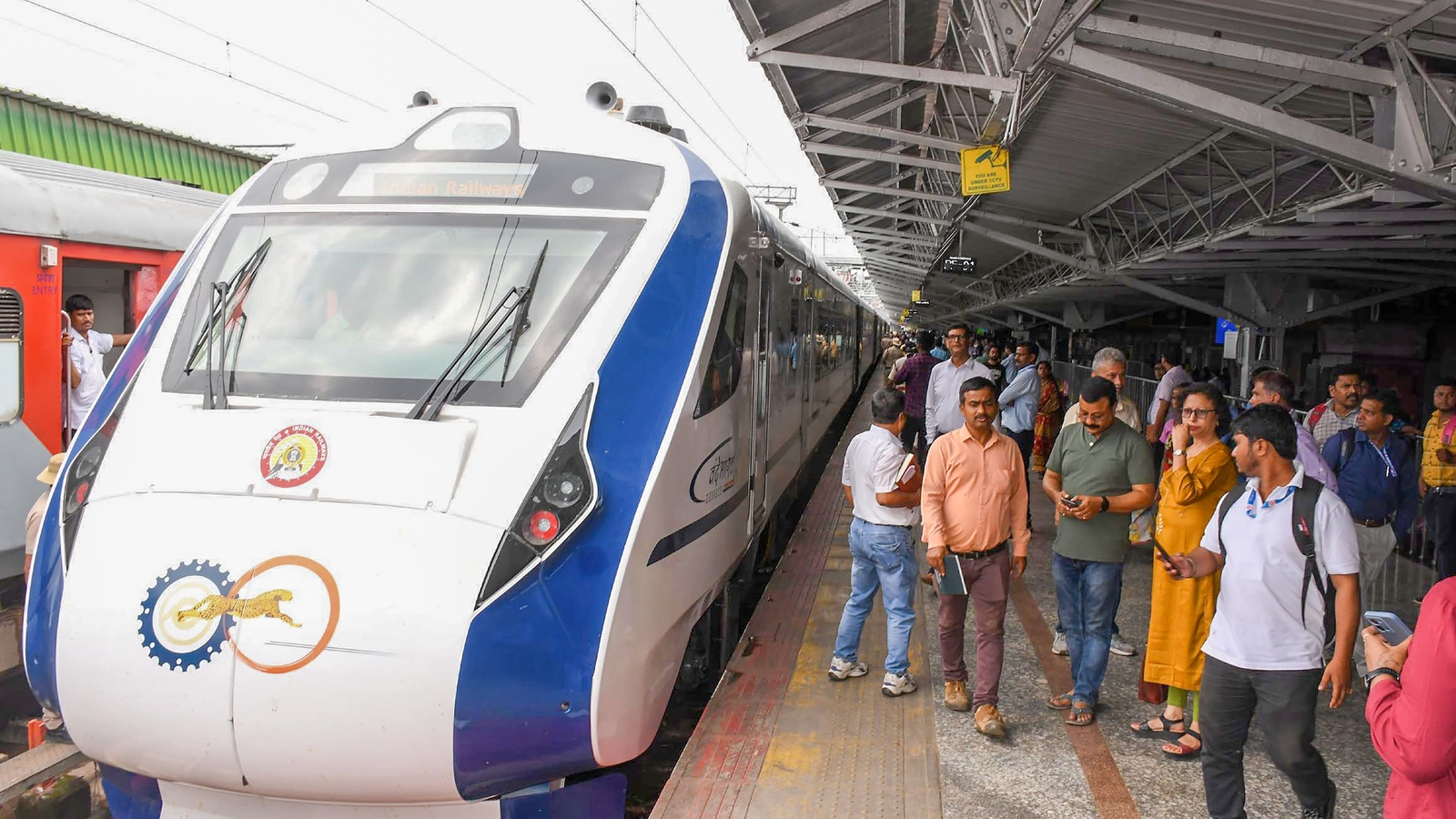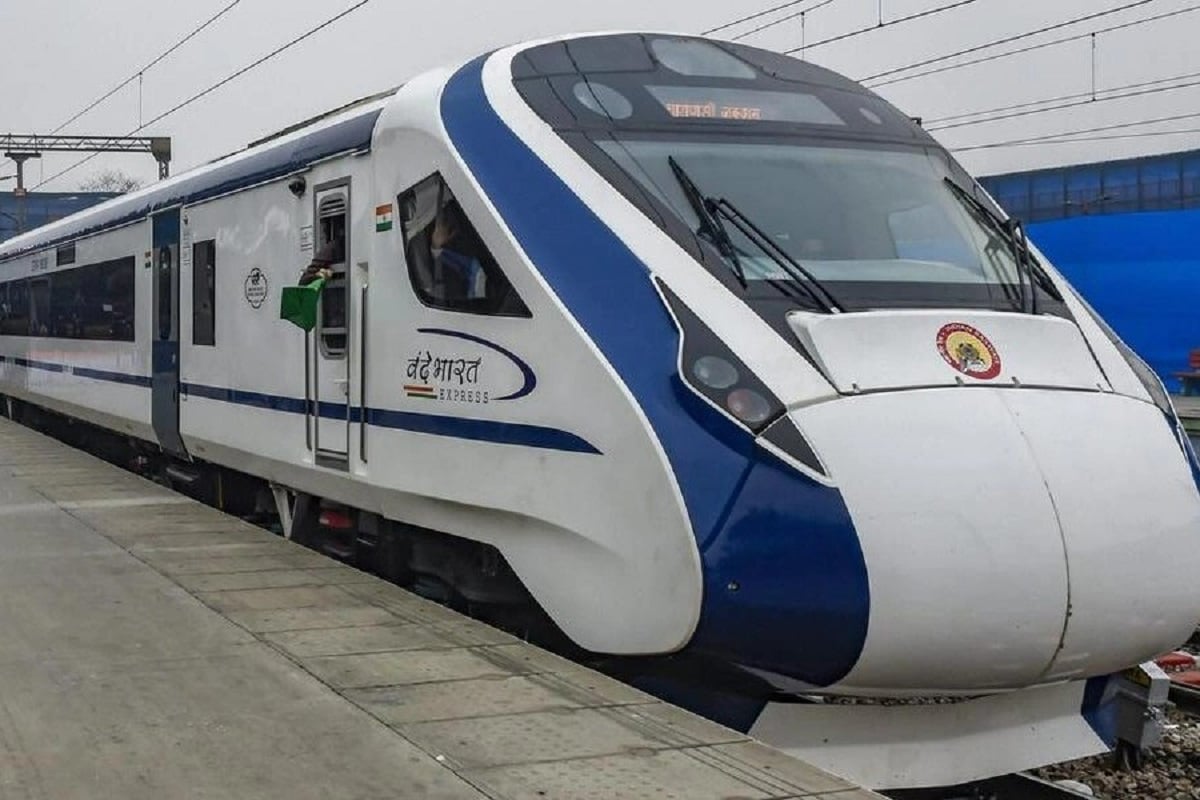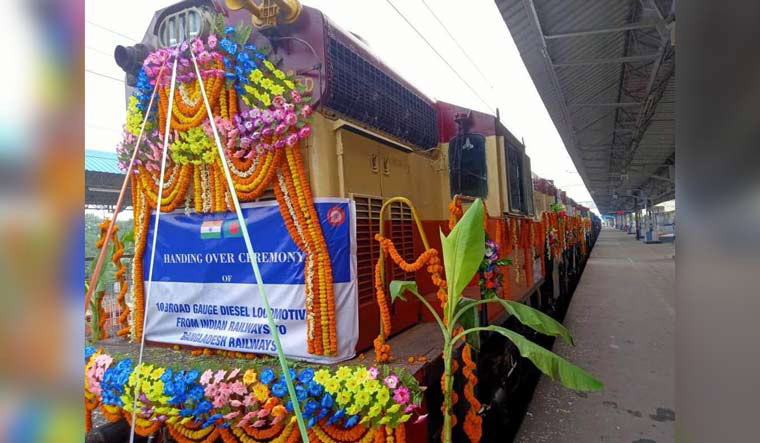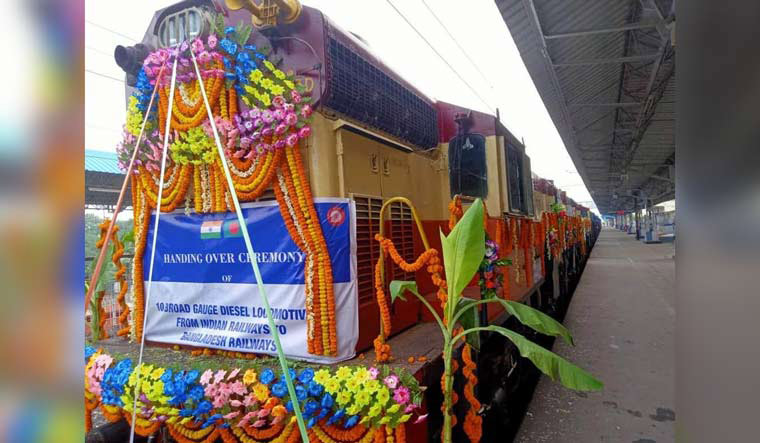India, Bangladesh ‘railway diplomacy’ enhancing brotherly ties, connectivity
24.05.23 - Bangladesh -
Pressenza New York
One of the ten broad gauge locomotives given by India to Bangladesh on Monday | High Commission of India in Bangladesh's Twitter handle
In spite of its being the most convenient mode of communication, the railway in this country has never been exposed to its true potential. With its basic infrastructure tracing back more than a hundred years, it has suffered more neglect than perhaps any service sector since independence.
By Dr. Shakuntala Bhabani
The all-important move to activate the sector took place in the mid-eighties when for the first time some dynamic steps led to substantial revamping, resulting in remarkable improvement in terms of an increased number of locomotives, introduction of inter-city trains with reasonably good maintenance of timetables, near-perfect ticketing arrangements, improved signaling and so on. However, Bangladesh now focuses on railway connectivity to ease the communion of the people. But Bangladesh Railway (BR) is trudging along because of its excessive reliance on outdated locomotives caused by the failure to add new engines to its fleet in time. The BR has long been struggling to run its services with outdated engines, but the situation deteriorated after more than 100 new trains were added to its fleet over the last decade. Bangladesh also bought some locomotive engines to meet the demand. But that is not sufficient.
Amidst this, India provided 20 more locomotives (engines) as a grant to Bangladesh Railways. India handed over the broad-gauge engines to Bangladesh Railway on May 23, 2023. The railway ministers of the two countries attended the locomotive handover ceremony virtually from the Darshana of Bangladesh and the Gede part of India respectively. The engines might help Bangladesh to some extent in tackling some shortage of engine crisis.
In a meeting held between the two railway ministers of Bangladesh and India on July 1 last year, a request was made to grant 20 broad gauge locomotives to Bangladesh Railways. In the Inter-Governmental Railway Meeting (IGRM) held at the Railway Building in New Delhi, India from August 29 to 31 of the same year, the government decided to take quick action to grant 20 broad gauge locomotives to Bangladesh Railways. India agreed to provide the rail engines during Prime Minister Sheikh Hasina’s visit to India in September last year.
This is the second time in three years that India is providing locomotives to Bangladesh following requests by Bangladesh Railway.
Earlier, Bangladesh Railways received 10 broad gauge locomotives from India as a donation in 2020. The locomotives found earlier are plying on the western route.
According to the information of Bangladesh Railway, the total number of engines currently in the company’s fleet is 307. Out of this, 197 engine meter gauges, majority of which are running in the eastern part of the railway. On the other hand, 110 broad gauge engines are operating in the western region. At present, about 400 trains are being operated by the Railways. In contrast to these trains, the number of running engines is only 271. Naturally, the company is suffering from engine shortage, due to which normal operations are disrupted.
On the other hand, the majority of the engines in the fleet have reached the end of their economic life. Although the economic life of railway engines is fixed at 20 years, most of the engines are over 40 years old. Most of the trains are not able to run at the desired speed with these old engines, the working hours of the engines have decreased.
The old engines have to be taken to the factory for frequent repairs. According to Bangladesh Railway’s Engineering (Locomotive) Branch data, taking the engine to the factory for repair is part of normal operations. But it has a certain limit.
As per the norms set by the Railways, 80 percent of the total number of engines should be kept for daily use. The remaining 20 percent will be in servicing. At present, the ratio of repairable and serviceable engines is higher than the prescribed standards. In such a context, the officials of the organization think that the Indian broad-gauge engines will speed up the railway management system.
India requested Bangladesh to receive 20 diesel-powered broad-gauge engines as a grant in December last year. But due to some procedural complications, they didn’t come to the country so far. Finally, On May 23, 2023, India officially handed over 20 locomotives to Bangladesh.
The 20 engines that India donated as a grant have been visited by Bangladesh railway officials in India earlier. Bangladesh Railways sent a seven-member inspection team from the Ministry of Railways to India on November 30 last year to see the donated locomotives. The inspection team submitted a report to the Ministry of Railways on December 15 last year.
They were told in that report that they had seen 34 locomotives in India. Among them, 20 locomotives have been selected for donation after evaluating the technical issues.
The 20 engines that India supplied Bangladesh recently were manufactured in 2017-18. In selecting the engines, it has taken into consideration whether they will be compatible with the overall railway network of Bangladesh including railways, stations, and signal system.
“India would never go back on its word in this endeavor,” stated the Indian rail minister recently, assuring Bangladesh of full assistance in improving the latter’s rail system. India is indeed helping Bangladesh enhance its railway infrastructure, particularly in converting the entire train network to broad gauze. This railway diplomacy may be “another milestone” in strengthening India-Bangladesh ties.
Following the execution of a Memorandum of Understanding (MoU) between India and Bangladesh, the broad-gauge engines were brought into the country after detailed verification of specifications, import clearance, customs duty, VAT, and tax procedures, said railway officials.
India and Bangladesh have been pursuing ‘Railway diplomacy’ in different ways. For example, however
, following the commencement of the Covid-19 epidemic, passenger rail services between Bangladesh and India were discontinued in March 2020. Before the suspension, two trains ran between the two countries: the Maitree Express between Dhaka and Kolkata and the Bandhan Express between Khulna and Kolkata.
But it was a piece of good news for both Indian and Bangladeshi people that passenger train services between India and Bangladesh resumed on May 29, 2022. It is two years after they were suspended owing to the outbreak of the pandemic on March 28, 2020, with the Bandhan Express departing Kolkata for Khulna and the Maitree Express departing Dhaka for Kolkata. The two countries’ railway ministers have already hailed the Mitali Express, a third train, on June 01, 2022.
Mitali Express, the third passenger train service connecting Bangladesh and India, began operating on June 01, 2022. The train travels 513 kilometers between New Jalpaiguri and Dhaka (Dhaka Cantonment station) in nine hours.
The India-Bangladesh railway connectivity has not only improved people-to-people contact between the two countries but it is also intended to boost tourism between them.
Shopping malls, hospitals, and low-cost hotels are also expected to be built in the vicinity, allowing people to move around the stations more efficiently. A hospital, shopping malls, and low-cost motels must be available near the station in the following days. But both parties must remove all hurdles and complexities regarding the bilateral trans service. Visa-related complexities should be addressed properly. The Target should be the welfare of the people from both sides. Millions of Indian and Bangladeshi citizens would be grateful to the Indian and Bangladeshi governments for restoring the train services. It would be much better if the procedure could be made more fluid.
This will help enhance trade between the two countries, and flourish tourism. The rail link will improve rail network access to the region’s key ports, dry ports, and land borders, supporting regional trade growth and encouraging regional economic and social development. The benefits of both products and passenger travel will be available to ordinary citizens and businesspeople in both countries. As a result, it will strengthen people-to-people communication even more. It will facilitate commercial activity and allow more people to contact one another.
The two countries have been collaborating to improve and expand rail connectivity. Both sides are working on several projects, and some historic railway lines are being restored at the same time.
The Bandhan Express was resurrected by reactivating a long-dormant rail link between Kolkata and Khulna, Bangladesh’s third-largest city. The Barishal Express served this route until 1965 when it was halted due to the India-Pakistan war. Bandhan was revived in 2017 by the Narendra Modi government and Sheikh Hasina administration.
Following the launch of the Maitree Express between Kolkata and Dhaka Cantonment in April 2008, the Bandhan Express was the second train to depart. It spans the distance between Kolkata and Khulna, passing through Petrapole and Benapole on the way to meet the needs of people from both countries.
Since its inception, the Maitree Express has been a huge success. The 90 percent occupancy rate on the tri-weekly route between Kolkata and Dhaka used to be the norm. Now, the Mitali Express has started to run between New Jalpaiguri and Dhaka in North Bengal.
Both countries’ governments have been attempting to improve the rail link between them, and not simply through passenger trains. The 20 engineer’s donation is a part of Indian railways contribution to build Bangladesh railway prosperous. In August 2021, the two countries resumed regular freight train service between Haldibari, India, and Chilahati, Bangladesh, on the newly restored link.
The Haldibari-Chilahati train link between India and East Pakistan was also operating until 1965 when it was shut down owing to the war. At the time of Partition, this was part of the broad-gauge major line connecting Kolkata and Siliguri. On this route, the two sides expect at least 20 freight trains to cross the border each month.
Trains continued to run between the two countries after the Partition because they were once part of a single, seamless railway network under British authority. As a result, the infrastructure to connect the two sides via railways was substantially there.
Policymakers on both sides saw this as an opportunity to strengthen diplomatic ties by allowing products and passengers to traverse borders. Between India and Bangladesh, five rail routes have restarted thus far. Petrapole (India)-Benapole (Bangladesh), Gede (India)-Darshana (Bangladesh), Singhabad (India)-Rohanpur (Bangladesh), Radhikapur (India)-Birol (Bangladesh), and the Haldibari-Chilahati connection are among them.
According to the media reports, stone chips, ballasts, grains, and other items are commonly transported to Bangladesh. CONCOR, a railway PSU, has begun container shipping with private clients’ Fast Moving Consumer Goods. Typically, the goal is to develop a speedier and more cost-effective freight link by weaning them off of the sea route. The Eastern Railway of India made it easier to import de-oiled soya cakes from Bangladesh last year.
Around 1.2 million tonnes of the cargo were transported via train in October of last year, rather than the customary route between the Nhava Sheva port and the Land Customs Stations, Petrapole Port.
There were eight railway interchanges between India and Pakistan before the 1947 division. Only five are currently operational: Benapole-Petropole, Darshana-Gede, Rohanpur-Singabadh, Biral-Radhikarpur, and Chilahati-Haldibari.
According to the media reports, the IR presented the plan to Bangladesh Railway (BR) in April this year. The infrastructure of the route from Gede-Darshana-Ishwardi-Abdullpur-Parbatipur-Chilahati-Haldibari.
The IR now has the opportunity to reestablish the ancient Siliguri-Sealdah route via Bangladesh, thanks to the resumption of train service on the Chilahati-Haldibari way.
According to the media reports, the proposed transit facility will save nearly three hours of journey time. At the moment, Indian trains must travel 573 kilometers from Sealdah in Kolkata to reach Siliguri. If the new route can be used, the distance will be reduced to merely 200 kilometers. Trains from Siliguri passed through Haldibari and entered Chilahati in former East Pakistan en route to Kolkata before 1965. This line was permanently closed after the Indo-Pak conflict in 1965. But the Resumption of India-Bangladesh passenger and freight train services will benefit both Bangladesh and India.
Transiting IR trains through Bangladesh may be a win-win situation for BR, IR, and the people and trade of the two nations. But there must have communication between the Northeast and Bangladesh, and the Akhaura-Agartala railway link must be resumed for both freight train and passenger trains as soon as possible which can mark yet another significant milestone for the two countries. The increased connectivity between the Northeast and Bangladesh will boost trade between the two countries.
Dr. Shakuntala Bhabani is a Kolkata-based educator and South Asian affairs researcher in the Political Science department at a Kolkata Honors College affiliated with the University of Calcutta.
In spite of its being the most convenient mode of communication, the railway in this country has never been exposed to its true potential. With its basic
www.pressenza.com









